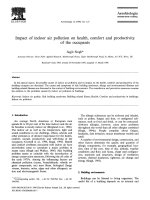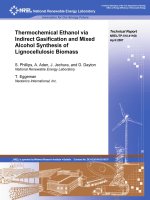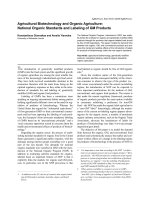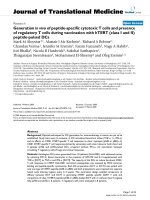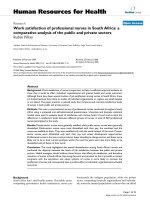6 Coating of Steel Structures Hydroblasting and Coating of Steel Structures pot
Bạn đang xem bản rút gọn của tài liệu. Xem và tải ngay bản đầy đủ của tài liệu tại đây (5.41 MB, 222 trang )
6
Coating
of
Steel Structures
Hydroblasting and Coating
of
Steel
Structures
H
yd
rob
I
ast
i
ng
and Coating
of
Steel Structures
Andreas
W.
Momber
Privatdozent, Department
of
Mining,
Metallurgy and Earth Sciences,
RWTH
Aachen Germany
ELSEVIER
UK
USA
JAPAN
Elsevier Ltd, The Boulevard, Langford Lane, Kidlington, Oxford
OX5
lGB,
UK
Elsevier Inc, 360 Park Avenue South, New York,
NY
10010-1710, USA
Elsevier Japan, Tsunashima Building Annex, 3-20-1 2 Yushima,
Bunkyo-ku, Tokyo
1
13, Japan
Copyright
0
2003 Elsevier Science Ltd.
All
rights reserved.
No
part of this publication may be reproduced, stored
in
a retrieval
system or transmitted in any form or by any means: electronic, electrostatic, magnetic
tape, mechanical, photocopying, recording or otherwise, without permission
in
writing
6-om
the publishers.
Cover illustration: Courtesy of Muhlhan Surface Protection International GmbH,
Hamburg, Germany
British Library Cataloguing in Publication Data
Momber, Andreas W., 1959-
Hydroblasting and coating of steel structures
1.Water jet cutting 2.Stee1, Structural
-
Cleaning
3.Building, Iron and steel
-
Cleaning
1.Title
620.1’06
ISBN 185617395X
Library of Congress Cataloging-in-Publication Data
Momber, Andreas
W.,
19
59
-
Hydroblasting and coating of steel structures
/
Andreas
W.
Momber
Includes bibliographical references and index.
ISBN 1-85617-395-X (hardcover)
p.
cm.
1.
Steel, Structural
-
Corrosion. 2. Corrosion and anti-corrosives.
I.
Title.
TA467 .M545 2002
620.1’723 -dc2
1
2002040768
No responsibility is assumed by the Publisher for any injury andlor damage to
persons or property
as
a
matter of products liability, negligence
or
otherwise, or
from any use or operation of any methods, products, instructions
or
ideas contained
in the material herein.
Published by
Elsevier Advanced Technology,
The Boulevard, Langford Lane, Kidlington, Oxford OX5
lGB,
UK
Tel: +44(0) 1865 843000
Fax:
+44(0) 1865 843971
Typeset by Newgen Imaging Systems (P) Ltd, Chennai, India
Printed and bound in Great Britain by Biddles Ltd, Guildford and King’s Lynn
Contents
List
of
Symbols and Abbreviations Used
1
Introduction
1.1
Definitions
of
surfaces and preparation methods
1.2 Importance
of
surface preparation processes
1.3 Subdivision
of
water jets
1.4 Industrial applications
2
Fundamentals
of
Hydroblasting
2.1 Properties and structure
of
high-speed water jets
2.2 Basic processes
of
water drop impact
2.3 Parameter influence on the coating removal
2.4 Models of coating removal processes
3
Hydroblasting Equipment
3.
I
3.2 Pressure generator
3.3 High-pressure hoses and fittings
3.4 Hydroblasting tools
3.5
Nozzle carriers
3.6 Hydroblasting nozzles
3.7 Vacuuming and water treatment systems
High-pressure water jet machines
4
Steel Surface Preparation by Hydroblasting
4.1 Efficiency
of
hydroblasting
4.2 Cost aspects
4.3 Problems
of
disposal
4.4 Safety features of hydroblasting
5
Surface Quality Aspects
5.1 Surface quality features
5.2
Adhesion strength
5.3
Flash
rust
5.4 Non-visible contaminants
-
salt content
vii
17
18
24
29
38
45
46
47
55
59
63
66
73
77
78
84
87
94
113
114
114
121
126
vi Contents
5.5 Embedded abrasive particles
5.6 Wettability of steel substrates
5.7 Roughness and profile of substrates
5.8 Aspects of substrate surface integrity
6
Hydroblasting Standards
6.1 Introduction
6.2 Initial conditions
6.3
6.4 Non-visible surface cleanliness definitions
6.5 Flash rusted surface definitions
6.6 Special advice
Visual surface preparation definitions and cleaning degrees
7
Alternative Developments in Hydroblasting
7.1 Pulsed
liquid
jets for surface preparation
7.2
Hydro-abrasive jets for surface preparation
7.3 High-speed ice jets for surface preparation
7.4 Water jethltrasonic device for surface preparation
References
133
136
138
144
149
150
151
152
154
155
157
159
160
169
176
181
183
Appendix
199
Index
203
~ ~
List
of
Symbols and
Abbreviations
Used
model parameter
jet structure parameter
cleaned surface
cleaning rate
nozzle (orifice) cross section
plunger cross section
jet structure parameter
fatigue parameter
cleaning energy flux
speed of sound water
constant
speed
of
sound target
paint consumption
jet spreading coefficient
paint degradation rate
drop diameter
maximum drop diameter
Sauter diameter (water drop)
dry film thickness
hose diameter
jet diameter
nozzle (orifice) diameter
plunger diameter
threshold nozzle diameter
cleaning effectiveness
kinetic energy hydro-abrasive jet
cleaning efficiency
kinetic energy water jet
Young’s modulus
kinetic energy abrasive particle
specific energy
frequency pulsating liquid jet
viii
List
of
Symbols
and
Abbreviations
Used
plunger rod force
reaction force
acceleration due to gravity
erosion depth
erosion rate
geodetic height
coating thickness
micro hardness
stroke
erosion intensity
jet impulse flow
internal roughness
damage accumulation parameter
hose length
coating performance life
abrasive mass flow rate
coating mass loss rate
mass loss coating material
model parameter
solid mass
water mass flow rate
life cycle (fatigue) number
crank-shaft speed
drop number
plunger number
cleaning steps
Ohnesorge number
pressure
atmospheric pressure
power density water jet
hydraulic power
cavitation pressure
jet power
optimum pressure
stagnation pressure
theoretical hydraulic power
threshold pressure
pressure
loss
actual volumetric flow rate
loss
in volumetric flow rate
nominal volumetric flow rate
volumetric flow rate water
erosion resistance parameter
rust rate
specific disposal rate
Re Reynolds number
List
of
Symbols and Abbreviatios Used
ix
ZC
ZF
rust grade
mixing ratio
pressure ratio
substrate roughness factor
radial distance nozzle-rotational centre
paint lifetime parameter
erosion strength
Strouhal number
surface preparation parameter
solid by volume (paint)
water jet velocity standard deviation
exposure time
blasting time
nozzle down time
interface fracture energy
impact duration
turbulence
working time
theoretical jet velocity
abrasive particle velocity
crank-shaft circumferential velocity
drop velocity
flow velocity
jet velocity
average jet velocity
nozzle (orifice) flow velocity
average plunger speed
traverse rate
water consumption
cleaning width
Weber number
jet length: stand-off distance
critical stand-off distance
water jet core length
water jet transition zone length
traverse parameter
acoustic impedance coating
acoustic impedance water
acoustic impedance substrate
hose pressure
loss
power
loss
coating thickness parameter
impedance ratio
nozzle (orifice) flow parameter
erosion
response parameter
abrasive mixing efficiency parameter
x
List
of
Symbols and Abbreviations Used
crank-shaft angle
gas content
model parameter
paint loss correction factor
DFT
conditioning factor
efficiency parameter
impact angle
model parameter
pump efficiency
kinematic viscosity water
hydraulic efficiency
mechanical efficiency
transmission efficiency
model parameter
model parameter
stress coefficient
mode1 parameter
nozzle (orifice) efficiency parameter
Poisson’s ratio coating
dynamic viscosity water
contact angle
model parameter
nozzle (orifice) angle
coating density
density air
density target
density liquid
average surface stress
impact stress (water hammer pressure)
surface tension water
endurance limit coating material
ultimate strength
rotational speed
compressibility parameter
hose friction number
volume loss parameter
CHAPTER
1
I
n
t
rod
u
ct
ion
1.1
1.2
1.3
Subdivision of Water Jets
Definitions
of
Surfaces and Preparation Methods
Importance
of
Surface Preparation Processes
1.3.1
Definitions and Pressure Ranges
1.3.2
Fluid Medium and Loading Regime
1.4.1 General Statement
1.4.2 Industrial Cleaning
1.4.3
Civil
and
Construction Engineering
1.4.4 Environmental Engineering
1.4
Industrial Applications
2
Hydroblasting and Coating
of
Steel Structures
1.1
Definitions of Surfaces and Preparation Methods
Surface preparation processes affect performance and lifetime of coating systems
significantly. Surface preparation is defined in
IS0
12944-4 as ‘any method of
preparing a surface for coating.’ Surface preparation is an important part of any
steel corrosion protection strategy. This is illustrated in Fig.
1.1
which shows major
factors for the selection of a corrosion protection system.
A
surface that is prepared for painting or coating is usually denoted ‘substrate’.
A
definition for substrate is: ‘The surface to which the coating material is applied or
is to be applied.’
(IS0
12944-1). Therefore, a substrate is generally generated from an
existing surface.
A
substrate is a prepared or treated surface. Surfaces that are pre-
pared by different methods include the following types
(IS0
12944-4):
(i) Uncoated surfaces
Uncoated surfaces consist of bare steel, which may be covered by mill scale
or rust and other contaminants. They will be assessed in accordance with
IS0
8501-1 (rust grades
A,
B,
C
and
D).
0
surfaces thermally sprayed with zinc, aluminium or their alloys;
0
hot-dip-galvanised surfaces:
0
zinc-electroplated surfaces:
0
sherardised surfaces.
Surfaces painted with prefabrication primer
Surfaces painted with prefabrication primer consist of automatically blast-
cleaned steel to which a prefabrication primer has been applied automati-
cally in a plant.
(iv) Other painted surfaces
Other painted surfaces consist of steel/metal-coated steel which has
already been painted.
(ii)
Metal-coated surfaces
(iii)
Local demands
Protective coating system
Evaluation process for a protective coating system (Pietsch and Kaisel:
2002).
Figure
I.
1
Introduction
3
Definitions and subdivisions of steel surface preparation methods are listed in
IS0
12944-4
(1998).
Basically, the following three principal surface preparation
methods can be distinguished:
(i)
(ii) mechanical cleaning including blast-cleaning:
(iii)
flame cleaning.
water, solvent and chemical cleaning:
Typical cleaning operations performed with these methods are listed in Table
1.1.
Table
1.1
Matter to be Procedure Remarks’
removed
Procedures
for
removal
extraneous
layers
and
foreign
matter
(IS0
12944-4).
Grease and oil Water cleaning
Steam cleaning
Emulsion cleaning
Alkaline cleaning
Organic-solvent cleaning
Water-soluble
contaminants,
e.g. salt
Mill scale
Rust
Water cleaning
Steam cleaning
Alkaline cleaning
Acid pickling
Dry abrasive
blast-cleaning
Wet abrasive
blast-cleaning
Flame cleaning
Same procedures as
for
mill scale,
plus:
Power-tool cleaning
Fresh water with addition of detergents. Pressure
<70
MPa may be used. Rinse with fresh water.
Fresh water. If detergents are added, rinse with
fresh water.
Rinse with fresh water.
Aluminium. zinc and certain other types of metal
coatings may be susceptible to corrosion
if
strongly
alkaline solutions are used. Rinse with fresh water.
Many organic solvents are hazardous to health. If the
cleaning is performed using rags, they will have to
be replaced
at
frequent intervals as otherwise oily and
greasy contaminants will not
be removed but will be
left as
a
smeared film after the solvent has evaporated.
Fresh water. Pressure
<
70
MPa may be used.
Rinse with fresh water.
Aluminium, zinc and certain other types of metal
coating may be susceptible to corrosion if strongly
alkaline solutions are used. Rinse with fresh water.
The process
is
normally not performed on site.
Rinse with fresh water.
Shot
or grit abrasives. Residuals of dust and loose
deposits will have to be removed by blowing
off
with dry oil-free compressed air or by vacuum cleaning.
Rinse with fresh water.
Mechanical cleaning will be required to remove
residues from the combustion process, followed by
removal
of
dust and
loose
deposits.
Mechanical brushing may bc
used
in areas
with
loose
rust. Grinding may be used for firmly adhering rust.
Residuals of dust and loose deposits will have to be
removed.
4
Hydroblasting and Coating
of
Steel
Structures
Table
1.1
Continued
~~
Matter to be Procedure
removed
Remarks’
Water blast-cleaning
Spot blast-cleaning
Paint coatings Stripping
Dry abrasive
blast-cleaning
Wet abrasive
Water blast-cleaning
blast-cleaning
Sweep blast-cleaning
Spot blast-cleaning
Zinc corrosion Sweep blast-cleaning
products
Alkaline cleaning
For removal of
loose
rust. The surface profile
of
the
For
localised removal
of
rust.
Solvent-borne pastes
for
coatings sensitive
to
steel is not affected.
organic solvents. Residues
to
be removed
by
rinsing
with solvents. Alkaline
pastes
for saponifiable
coatings. Rinse thoroughly with fresh water. Stripping is
restricted
to
small areas.
Shot or grit abrasives. Residues of dust and
loose
deposits
will
have to be removed by blowing off with
dry oil-free compressed air by vacuum cleaning.
Rinse with fresh water.
For
removal of poorly adhering paint coatings.
Ultra-high-pressure
(X70
MPa) cleaning may
be
used
for firmly adhering coatings.
coating layer.
For roughening coatings
or
removal
of
the outermost
For localised removal
of
coatings.
Sweep blast-cleaning on zinc may be performed with
5%
(m/m) ammonia solution in combination with
aluminium oxide (corundum), silicates or olivine sand.
a synthetic-fabric pad with embedded abrasives may
be
used
for larger surfaces. At high pH, zinc
is
susceptible
to
corrosion.
‘When rinsing and drying, structures with slots
or
rivets shall
be
treated with particular care.
Water, solvent and chemical cleaning includes the following methods:
water cleaning:
steam cleaning:
emulsion cleaning:
alkaline cleaning:
organic-solvent cleaning:
cleaning
by
means of chemical conversion:
stripping:
acid picking.
The methods of mechanical cleaning are given in Fig. 1.2. Blast-cleaning methods
are further subdivided in Table
1.2.
Hydroblasting is denoted as
water blast-cleaning
(marked in Fig. 1.2) in terms of
IS0
12944-4,
and is defined
as
follows:
‘This
method consists in directing a jet of pressurised clean, fresh water on
to
the surface
to be cleaned.
The
water pressure depends on the contaminants to
be
removed,
such as water-soluble matter, loose rust and poorly adhering paint coatings.’
lntroduction
5
I
Mechanical cleaning methods
I
(Hydroblasting)
Figure
1.2
Mechanical cleaning methods according
to
IS0
12944-4,
and classification
of
hydroblasting
Table
1.2
Blast-cleaning methods according to
IS0
12944-4.
Dry abrasive blast-cleaning
Moisture-injection abrasive
Wet abrasive blast-cleaning
blast-cleaning
Particular applications
of
blast-cleaning
Centrifugal abrasive blast-cleaning.
Compressed-air abrasive blast-cleaning.
Vacuum or suction-head abrasive
(no
further subdivision).
blast-cleaning.
Compressed-air wet abrasive blast-cleaning.
Slurry blast-cleaning.
Pressurised-liquid blast-cleaning.
Sweep blast-cleaning.
Spot blast-cleaning.
1.2
Importance
of
Surface Preparation Processes
IS0
8
502
states the following: ‘The performance of protective coatings of paint and
related products applied to steel is significantly affected by the state of the steel sur-
face immediately prior to painting. The principal factors influencing this perform-
ance are:
0
0
0
the surface profile.’
the presence of rust and mill scale:
the presence of surface contaminants, including salts, dust, oil and greases:
The importance of surface preparation for coating performance may be illustrated
based on a recently introduced coating performance model. Adamson
(1998)
devel-
oped a mathematical model for predicting coating lifetime, and for foreseeing coat-
ing degradation rate. This model considers the following parameters:
0
total dry film thickness:
0
surface preparation methods:
0
environmental classification:
0
rustgrade:
0
paint type.
6
HydrobJasting and Coating
of
Steel Structures
A first approximation of paint degradation rate
is
obtained using the following
equation:
The performance life of a coating system
in
years for a given environment for a des-
ignated rust grade of
RG
=
4.5,
can be calculated using the following approach:
Both equations are rather complex
in
structure and certain classified information
is
required to solve them. Most
of
this information is given in the original work
(Adamson,
1998).
Of
particular interest are the parameters
SI?
mD
and
nL
because
their values depend on surface preparation standard and quality. Degradation rate
basically depends on surface preparation standard as follows:
D
l/SPmD. (1.3)
Here, the term
(1
+mD)
is neglected. Lifetime depends
on
surface preparation stand-
ard according to a simplified function:
where
C,
summarises other parameters. Three levels
of
surface preparation based on
SSPC
designation are used in the calculations:
SP
10
(near white),
SP
6
(commercial
blast) and
SP
3
(power tool cleaning). Note that cleaning intensity increases as the
number for
'SP'
increases. Exponential indices
nL
(for lifetime estimation) and
mD
(degradation rate) are assigned according to these quality levels. The relationships
are explained in Table
1.3.
The power functions included in
Eqs.
(1.1)-(1.4)
are
graphically illustrated in Fig.
1.3.
From this figure, lifetime increases and degrada-
tion rate decreases
if
surface preparation standard increases. These results of
preliminary calculations illustrate the importance of a high-quality surface
preparation for coating performance. These model calculations are verified through
experimental results presented in Fig.
1.3
where a substantial improvement
in
corrosion protection performance of two coating systems can be seen
if
surface
Table
1.3
Surface
preparation
indices (Adamson,
1998).
Surface preparation Designation Indices
SSPC-SPINACE
IS0
nL
mV
Near-white blast SP 10INACE
2
Sa
2.5
0
0
Commercial blast
SP
6INAcE
3
Sa
2 0.5
-0.07
Power tool SP
3
St
3
1.35
-0.35
Introduction
7
m
\
ZC
\
rnC
\
\
Y
c
L
OO
3
6
10
Cleaning degree
SP
(SSPC)
Figure
1.3
Surface preparation parametersfor Eqs.
(1.1)+1.4).
3
Organic zinc coating
7
Epoxy
coatings
SP-10
I
~
SP-3
1
SP-2
mill scale
Surface condition
Figure
1.4
Effect of surface quality
on
corrosion protection (Kogler
et
al.,
1995).
preparation level increases. Figure
1.4,
taken from an independent reference, verges
these results. The average percentage of rusting decreases notably
if
the quality of
surface preparation improves.
Vocational training in the area of corrosion protection spends much attention to
surface preparation issues.
In
Norway, as an example, advanced training courses
for surface treatment offer the following topics (Hartland,
2000):
corrosion
(8%);
8
Hydroblasting and
Coating
of
Steel Structures
surface preparation
(20%);
application
(24%);
materials
(20%);
equipment and
machinery
(12%);
health, safety and environment
(8%);
specification, control and
reporting
(8%).
The percentage for the educational module ‘surface preparation’
(20%) illustrates the importance of this particular area.
1.3
Subdivision
of
Water
Jets
1.3.1
Definitions and Pressure Ranges
The tool of any hydroblasting application is a high-speed water jet. Although the
speed of the jet is its fundamental physical property, the pressure generated by the
pump unit that produces the jet is the most important evaluation parameter
in
prac-
tice. Fundamentals of jet generation are provided in Chapter
3.
According to the Water Jet Technology Association, St Louis, water jet applica-
tions can be distinguished according to the level of the applied operational pressure
(WJTA,
1994)
as follows:
0
Pressure deaning:
The use
of
pressurised water, with or without the addition of
other liquids or solid particles, to remove unwanted matter from various sur-
faces, and where the pump pressure is below
340
bar.
High-pressure water cleaning:
The use of high-pressure water, with or without
the addition of other liquids or solid particles, to remove unwanted matter
from various surfaces, and where the pump pressure is between
340
and
2000
bar.
Ultra high-pressure water cleaning:
The use of pressurised water, with or with-
out the addition of other liquids or solid particles, to remove unwanted mat-
ter from various surfaces, and where the pump pressure exceeds 2000 bar.
0
0
However, this designation considers all fields of application and does not distin-
guish between different applications, such as hydrodemolition, decontamination
ur
hydroblasting. Therefore, a designation that meets the requirements
of
hydro-
blasting applications may be applied. Such a designation is given in the standard
SSPC-SP
12/NACE
No.
5
(2002)
as follows:
0
0
0
0
Low-pressure water cleaning
(LPWC):
Water cleaning performed at pressures
less than
34
MPa. This
is
also called ‘power washing’ or ‘pressure washing’.
High-pressure water cleaning
(HPWC):
Water cleaning performed at pressures
from
34
to 70 MPa.
High-pressure water jetting
(HPWJ):
Water jetting performed at pressures from
70 to 2
10
MPa.
Ultrahigh-pressure water jetting
(UHPWJ):
Water jetting performed at pres-
sures above 2
10
MPa.
Following the above designation, this book deals with
HPWJ
and
UHPWJ.
It consid-
ers
in
particular applications with operating pressures in excess of
150
MPa.
Introduction
9
1.3.2
Fluid Medium and loading Regime
According to the liquid medium, the following modifications can be distinguished
0
plain water jets:
0
0
additive water jets: water jets with soluble additives (Howells, 1998);
abrasive water jets: water jets with non-soluble additives (Momber and
Kovacevic, 1998).
Abrasive water jets divide further according to their generation and phase com-
position into injection-abrasive water jets, and suspension-abrasive water jets. An
injection-abrasive water jet consists of water, air and abrasives, and is considered to
be a three-phase jet. In contrast, a suspension-abrasive water jet does not contain air
and, therefore, is a two-phase jet. Formation, behaviour and applications of abrasive
water jets are in detail discussed by Momber and Kovacevic (1998) and Summers
(1995). This
book,
with the exception of Paragraph
7.2,
focuses on the application
of plain water jets.
Regarding the loading regime, the following types
two
can be distinguished:
0
continuous jets:
0
discontinuous jets (Vijay, 1998a).
Wiedemeier (1981) defines a jet as discontinuous,
if
it generates a discontinuous
load at the impact site. But as Momber (1993a) pointed out, every water jet
internally contains discontinuous phases resulting from pressure
fI
uctuations, jet
vibrations and droplet formation. He suggests that ‘discontinuous jets’ are formed
artificially by external mechanisms, whereas ‘continuous jets’ are not influenced
by external mechanisms. Reviews about the formation, properties and applica-
tions
of
discontinuous water jets are given
by
Labus (1991), Momber (1993a)
and Vijay (1998a). Although aspects of drop impact and jet disintegration are dis-
cussed in this book as well (see Paragraph
7.1),
it generally addresses continuous
water jets.
1.4
Industrial Applications
1.4.7
General Statement
Water jet technology is becoming a state-of-the-art technology not only in the area
of surface engineering but is also one of the most flexible techniques available in
industrial maintenance. In industry, water jet technology is frequently used in the
following areas:
0
building sanitation and rehabilitation:
0
concrete hydrodemolition:
0
decontamination and demilitarisation:
0
demolition of technical structures:
10
Hydroblasting and Coating
of
Steel Structures
3000
2500
s
2000
n
F
c
3
u)
1500
0-l
C
._
c
s
a,
8
1000
Enamel stripping
(gridirons, body skids)
Heavy concrete removal
tf
500
1T-c
Pipe cleaning
0
100
200
300
400
0
Volumetric
flow
rate in Vmin
Figure
1.5
Industrial applications
of
high-speed water jets.
foundation engineering:
industrial cleaning;
jet cutting of ceramics, fibre-reinforced plastics, food, glasses, metals and rocks;
maintenance of technical structures and equipment:
mechanical processing of minerals:
medical applications:
mining and rock cutting;
paint and lacquer stripping:
rock fragmentation:
sewer channel and pipe cleaning:
surface preparation for protective coatings (Hydroblasting).
Several of these applications as well as the corresponding major operational param-
eters are summarised in Fig.
1.5.
1.4.2
Industrial Cleaning
Industrial cleaning is the classical industrial application of the water jet technology
It dates back to the
1920s
when it was used for cleaning of moulds and castings
Introduction
11
(Lohse.
1929).
Later, as reliable high-pressure pumps were developed in the late
1950s.
the water jet revolutionised the areas of sewer and pipe cleaning. Today,
commercialised water jetting covers the following cleaning applications:
a
a
a
a
a
a
a
a
a
a
a
a
aircraft cleaning in the aviation industry: removal of paint, grease, dirt
(Hofacker,
199 3);
cement kiln and autoclave vessel cleaning in the construction materials
industry: removal of cement lips, incrustations, lime, solidified dust (Wood,
1996);
gridiron and body skid cleaning in the automotive industry: removal of
non-
hardened, sprayed lacquer (Halbartschlager,
198
5);
pipe cleaning in the municipal and chcmical industry: rcmoval
of
worn pro-
tective coatings, incrustations, solidified materials, etc. (Momber,
199
7:
Momber and Nielsen,
1998);
reactor, vessel and container cleaning in the chemistry and oil industry:
removal of production leftovers, especially resins, latex, adhesives, oils or plas-
tics (Geskin,
1998);
roller drum cleaning in the printing industry: removal of ink;
semiconductor frame cleaning in the electronic industry: removal
of
excess
resin (Yasui
et
a].,
1993);
municipal sewer cleaning: removal of deposits (Lenz and Wielenberg,
1998);
ship cleaning in the maritime industry: removal of marine growth, loosen
paint, dirt and rust;
sieve and filter cleaning in the process engineering industry: removal of pro-
duction leftovers, especially solidified agglomerates (Jung and Drucks,
199
6);
steel cleaning in steel mills: removal of weld slag, water scale, mill scale and
rust (Raudensky
et
al.,
1999);
tube bundle cleaning in the process engineering and oil industry: removal
of
incrustations and residues, especially calcium carbonate, from internal and
external tube surfaces (Momber, 2000~).
Some of these applications are shown in Fig.
1.6.
1.4.3
Civil and Construction Engineering
Water jetting is state-of-the-art technology in civil engineering.
A
recent review
given by Momber
(1998a)
includes an extensive database. Several aspects of civil
engineering use are also mentioned by Summers
(1995).
The applications include
the following:
a
a
a
a
a
decontamination
of
industrial floors:
cleaning of concrete joints prior to concreting (Utsumi
et
aL,
1999);
cleaning of concrete, stone, masonry and brick surfaces (Lee
et
aL,
1999);
cleaning of soils (Sondermann,
1998);
cutting and drilling of natural rocks in quarries (Ciccu and Bortolussi,
1998);
12
Hydroblasting and Coating of
Steel
Structures
(a) Aircraft cleaning (WOMA GmbH, Duisburg).
(d) Sewer cleaning (WOMA GmbH, Duisburg).
(b) Body skid cleaning (Hammelmann GmbH, Oelde).
(e) Ship hull cleaning (WOMA GmbH, Duisburg)
Pipe cleaning (Hammelmann GmbH, Oelde).
Figure
1.6
Industrial cleaning applications of water
jets.





